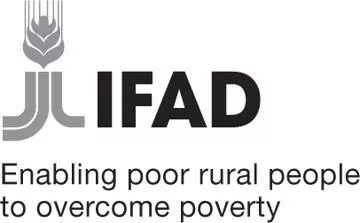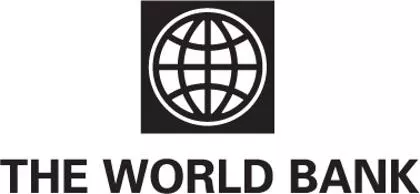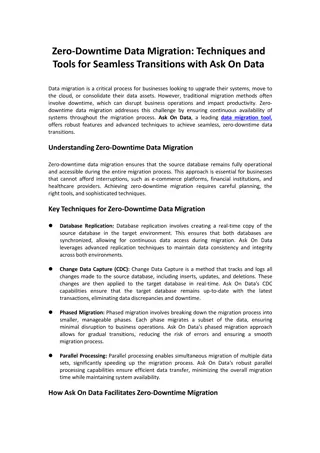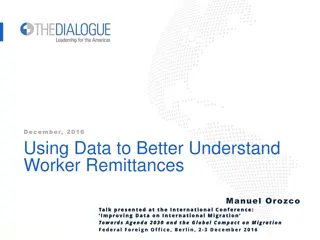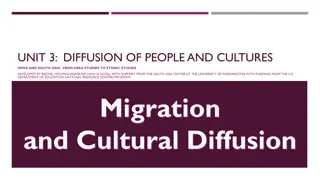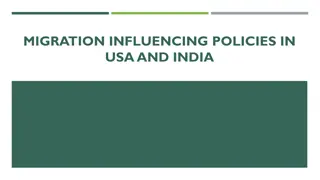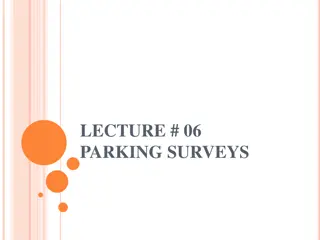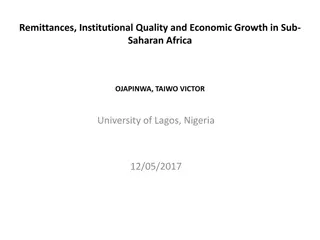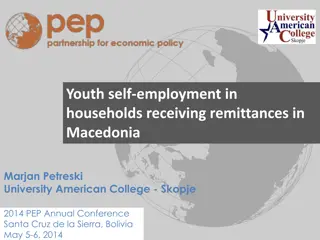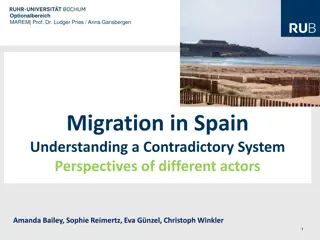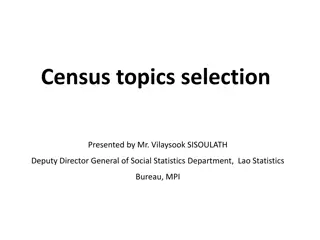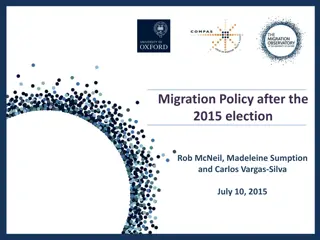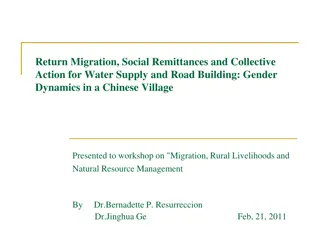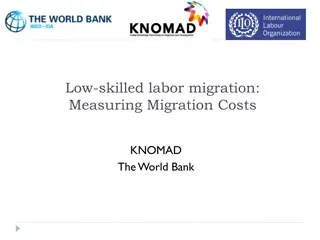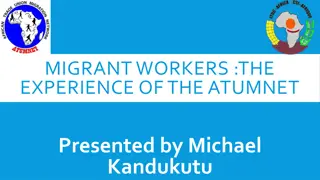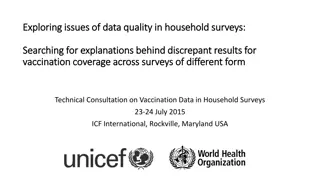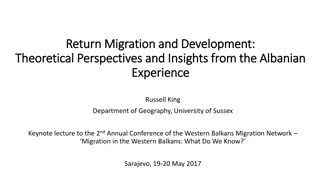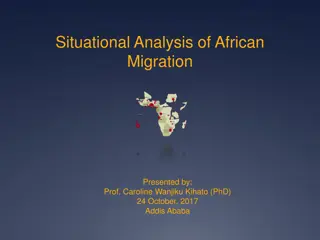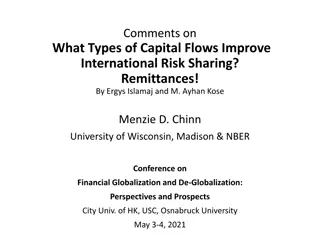Insights from Household Surveys on Migration and Remittances in Africa
Household surveys conducted between 1990-2006 revealed that migration and remittance data are scattered across survey sections. The surveys collect details on migration history, remittances, and more. Challenges include comparability issues, sampling frame absence, and fieldworker capacity. Coverage spans several African countries, with survey modules covering various aspects of households. However, limitations exist due to sample coverage, sampling variability, and sample bias.
Download Presentation

Please find below an Image/Link to download the presentation.
The content on the website is provided AS IS for your information and personal use only. It may not be sold, licensed, or shared on other websites without obtaining consent from the author. Download presentation by click this link. If you encounter any issues during the download, it is possible that the publisher has removed the file from their server.
E N D
Presentation Transcript
Findings from Household Surveys on Migration and Remittances Africa Migration Projet Sonia Plaza (The World Bank) February 12, 2015
Motivation A review of 70 household surveys conducted during 1990- 2006 found that migration and remittances data are spread across various sections of surveys but are rarely linked. 3 Main findings: Migration modules are sometimes found in a separate sections. Other times, the topic of migration is added to other modules. Most surveys collect data on the migration history of all household members above 10-15 years(typically); however, some collect information on household head only. Most surveys collect data on the migration of household members since birth but some limit to preceding one year. Remittances are captured as part of income and expenditures modules, but many of the surveys do not distinguish between remittances and other transfers.
Outline Survey features 4 Sample characteristics Main findings Household characteristics Housing Asset and expenditures Use of financial services Return migration
Methodological Challenges Comparability: changes in questionnaire and data collection 5 Data collection needs to be designed according to their objectives Absence of a proper sampling frame Fear of participation or to provide the information Length of the questionnaire Capacity and training of fieldworkers
Household survey coverage 6 Senegal Kenya Burkina Faso Nigeria Uganda South Africa
Basic survey features Survey type A single-round, cross-sectional survey was implemented as part of the project in six countries. Information about households with internal migrants, international migrants, and no migrants. Survey modules household roster housing conditions household assets and expenditure household use of financial services internal and international migration and remittances from former household members internal and international migration and remittances from non- household members return migration. 7
Limitations of the data Like all sample surveys, these household surveys only produce estimates that are limited by a number of factors. Sample coverage the sampling frame does not cover the whole population in all countries. Sampling variability all samples can differ from the population by chance (sampling error). Sample bias if the sample under/over-represents sections of the population the estimates may differ substantially from the population. Amount of data collected - these surveys were not designed to provide reliable "economic" statistics such as unemployment rates and average earnings. 8
Remittances questions Cash and in kind remittances: both 9 Who send the money: migrants (household member and non-household member) Internal and international remittances Channels (adapt to each condition) Frequency (always include a time frame) Purposes of the use of remittances
Main sample characteristics Households successfully interviewed Level of statistical representativeness Households screened Target sample Individuals interviewed Country 10 Sending country 10 most important provinces for migration Burkina Faso 9,177 2,106 2,102 18,704 17 districts with largest concentration of migrants households7,373 Kenya 2,000 1,942 8,372 Nigeria Nationally representative 8,075 2,000 2,251 13,414 Senegal Nationally representative 2,000 2,100 17,883 Uganda Nationally representative 24,618 2,000 1,961 9,138 Receiving country South Africa Main corridors: Limpopo/Gauteng 6,760 2,028 2,012 12,247
Characteristics of migrants from select African countries 11 Household characteristics Burkina Faso Ghana Nigeria Senegal Kenya Age (middle 50 percent) Migrants in OECD countries 35 37 33 38 34 Intra-African migrants 32 35 28 35 33 Internal migrants 32 35 27 32 31
Characteristics of migrants from select African countries 12 Household characteristics Burkina Faso Ghana Nigeria Senegal Kenya Gender (percent male) Migrants in OECD countries 79 70 72 80 57 Intra-African migrants 90 63 75 86 Internal migrants 82 62 62 75 61
Characteristics of migrants from select African countries Household characteristics Burkina Faso Ghana Nigeria Senegal Kenya 13 Education (percent with given level of education) Migrants in OECD countries 52 secondary 61 secondary 45 tertiary 44 tertiary 47secondary Intra-African migrants 65 primary 45 secondary 38 secondary 48 primary Internal migrants 45 secondary 54 secondary 49 secondary 35 primary 43 secondary Reason for emigration Employment 78 .. 48 48 54 Education 8 .. 29 29 38 Others 4 .. 4 3 2
Main findings Intraregional migration is still very predominant Migration Patterns have changed 14 West Africa (e.g, Senegal to Spain) East Africa (e.g, Gulf, Sudan, Dubai) Although old destination countries are still important: Ivory Coast, South Africa and Gabon Remittances: Unofficial channels still very predominant West Africa East Africa Access to new technologies in rural areas increase internal remittances
Migrant destinations Burkina Faso Ghana Nigeria Senegal Kenya OECD 2% 21% 17% 36% 30% 15 Africa 46% 5% 6% 16% 11% Internal 52% 74% 77% 47% 59% Total 100% 100% 100% 100% 100% Main destinations Burkina Faso Ghana Nigeria Senegal Kenya USA 22% UK 18% Other ECOWAS 16% Germany 6% C te d'ivoire - 85% Mali - 8% Ghana - 1% USA 24% UK 19% Italy - 26% Spain - 21% France - 12% US - 34% UK - 13% Uganda - 10% Otaly 11% Gabon - 1% Canada 6% Gambia - 10% Tanzania - 5% Germany 8% USA - 1% South Africa 6% C te d'ivoire - 4% Germany - 5%
Labor-market status of individuals, before and after migrating (percent) 16 Labor market status Burkina Faso Senegal Nigeria Kenya Before After Before After Before After Before After 80 64 42 43 10 5 21 8 3 5 9 8 3 9 9 24 1 12 3 4 2 2 9 3 1 3 7 10 80 64 42 43 7 9 Self-employed Student Housewife Full-time wage earner Part-time wage earner Unemployed Other Self-employed 16 43 1 14 3 22 2 16 26 23 5 34 4 4 4 26 31 2 21 4 33 1 7 16 3 53 8 8 3 9
Use of remittances by recipient households, by source Use Burkina Faso Kenya Nigeria Outside Africa 25.7 23.5 12.4 11.3 10.4 5.0 2.1 1.4 0.3 0.1 0.0 0.0 Within Africa Domestic 10.1 34.9 5.9 10.1 2.6 0.7 3.9 0.6 1.0 0.0 1.4 3.9 Outside Africa 11.2 12.8 Within Africa Domestic 27.5 14.5 22.9 5.8 8.4 .. 1.7 0.4 3.1 1.0 7.0 0.4 0.6 6.6 Outside Africa Within Africa Domestic 0.0 20.1 19.6 12.0 20.1 .. 1.0 4.9 3.2 0.0 16.6 .. .. 2.6 17 2.6 48.7 9.4 12.5 2.4 0.7 3.1 1.7 1.2 0.1 0.1 1.1 1.3 29.7 20.5 7.0 13.0 5.8 10.1 22.1 5.1 21.7 0.1 1.0 4.5 10.6 11.1 Construction - new house Food Education Health Business Clothing Marriage/funeral Rent (house, land) Rebuilding of house Cars/trucks Purchase of land Improvement of farma Investment Other 9.6 7.3 3.9 .. .. .. .. 0.9 5.7 5.3 1.3 8.4 2.3 24.2 7.2 2.0 7.4 1.3 0.4 1.3 4.4 4.7 6.9 0.4 4.4 4.7 0.0 24.8 ..7 ..8 7.0 0.5 18.2 .. .. .. .. .. .. 7.7 24.9 16.3 0.8 3.5
Use of remittances by recipient households, by source Use Senegal Uganda Outside Africa 7.0 52.6 3.6 10.7 1.3 Within Africa Domestic 0.7 72.6 2.3 7.3 5.7 .. 2.4 0.0 0.7 0.0 0.0 .. .. 8.3 Outside Africa Within Africa Domestic 1.6 9.7 14.5 14.5 9.7 .. 6.5 8.1 3.2 0.0 4.8 .. .. 27.4 18 0.0 81.9 4.6 2.9 0.2 2.5 7.6 12.7 6.3 7.6 0.4 12.4 20.2 24.8 2.1 Construction - new house Food Education Health Business Clothing Marriage/funeral Rent (house, land) Rebuilding of house Cars/trucks Purchase of land Improvement of farma Investment Other .. .. .. .. 2.9 1.0 4.2 0.2 3.0 1.1 2.2 0.1 0.0 0.0 7.6 5.1 6.3 2.5 3.8 1.7 4.5 2.1 0.0 2.1 .. .. .. .. .. .. .. .. 13.5 6.9 38.0 29.8
Channels used to send remittances Internal migrants Burkina Faso Ghana Kenya Nigeria Senegal Channel 19 Western Union Money Gram Other money transfer operator (MTO) Postal money order Direct transfer to bank account Bank as paying agent for MTO Foreign exchange bureau Credit union Travel agency Informal individual agents Mobile phone/telecom service providers Through friend or relative Courier, bus, or other transport Brought back himself during visit Pre paid cards/ATM card Internet money transfer Other Total 1 0 0 1 0 0 0 0 1 1 0 27 3 63 0 0 1 100 0 0 0 0 1 0 0 0 0 0 0 44 0 50 0 0 5 100 1 1 0 1 6 1 1 0 0 0 60 7 1 21 0 0 1 100 3 2 2 0 35 3 0 0 0 4 0 21 0 28 0 0 1 100 5 0 0 3 0 0 0 0 0 3 1 37 12 37 0 0 2 100
Channels used to send remittances Within-Africa migrants Burkina Faso Ghana Kenya Nigeria Senegal Channel 20 Western Union Money Gram Other money transfer operator (MTO) Postal money order Direct transfer to bank account Bank as paying agent for MTO Foreign exchange bureau Credit union Travel agency Informal individual agents Mobile phone/telecom service providers Through friend or relative Courier, bus, or other transport Brought back himself during visit Pre paid cards/ATM card Internet money transfer Other Total 10 1 0 3 0 0 0 0 0 3 0 64 3 15 0 0 0 100 17 6 0 0 0 0 0 0 0 0 0 43 0 30 0 0 4 100 24 12 2 2 11 1 2 0 0 3 24 9 4 8 0 0 0 100 31 3 1 1 12 18 1 0 0 4 0 15 0 13 0 0 0 100 30 1 0 6 0 0 0 0 0 4 0 41 1 14 0 0 2 100
Channels used to send remittances OECD migrants Burkina Faso Ghana Kenya Nigeria Senegal Channel 21 Western Union Money Gram Other money transfer operator (MTO) Postal money order Direct transfer to bank account Bank as paying agent for MTO Foreign exchange bureau Credit union Travel agency Informal individual agents Mobile phone/telecom service providers Through friend or relative Courier, bus, or other transport Brought back himself during visit Pre paid cards/ATM card Internet money transfer Other Total 32 9 2 0 0 2 0 0 0 0 0 18 0 34 0 0 2 100 54 6 14 0 2 0 0 0 0 0 0 18 0 4 0 0 2 100 43 20 1 1 8 8 7 0 1 1 2 4 0 2 0 0 0 100 51 5 0 0 12 11 0 0 0 2 0 13 0 5 0 0 0 100 74 6 2 3 0 1 0 1 0 2 0 10 0 1 0 0 0 100
Return migration in selected African countries (percent) 22 Burkina Faso Nigeria Senegal Returnees as a share of all migrants of which: Returned in less than 4 years Returned in 5 15 years Returned after more than 15 years 25 3 9 67 16 16 69 23 8 32 2 66
Housing status own (%) 23 Migration Status Burkina Faso Nigeria Senegal Ghana Domestic Migrants 92% 82% 88% 51% Within Africa Migrants 97% 73% 91% 44% OECD Migrants 83% 67% 85% 33% Non-Migrants 93% 73% 73% 45%
Construction material of dwelling Brick/stone Burkina Faso Nigeria Senegal Ghana 24 Domestic Migrants 9% 48% 65% 30% Within Africa Migrants 4% 82% 48% 50% OECD Migrants 48% 91% 90% 69% Non-Migrants 5% 41% 70% 46% Mud Burkina Faso Nigeria Senegal Ghana Domestic Migrants 90% 45% 21% 63% Within Africa Migrants 95% 16% 42% 43% OECD Migrants 48% 6% 3% 24% Non-Migrants 91% 56% 19% 49%
Summary of main findings Migrants are young people 25 Mean reason for migration is economic Senegal and Kenya: brain drain? Main use of remittances: consumption, health, education and housing New technologies are penetrating in rural areas in East Africa Return migration is high for seasonal/circular migration. Very little for others.
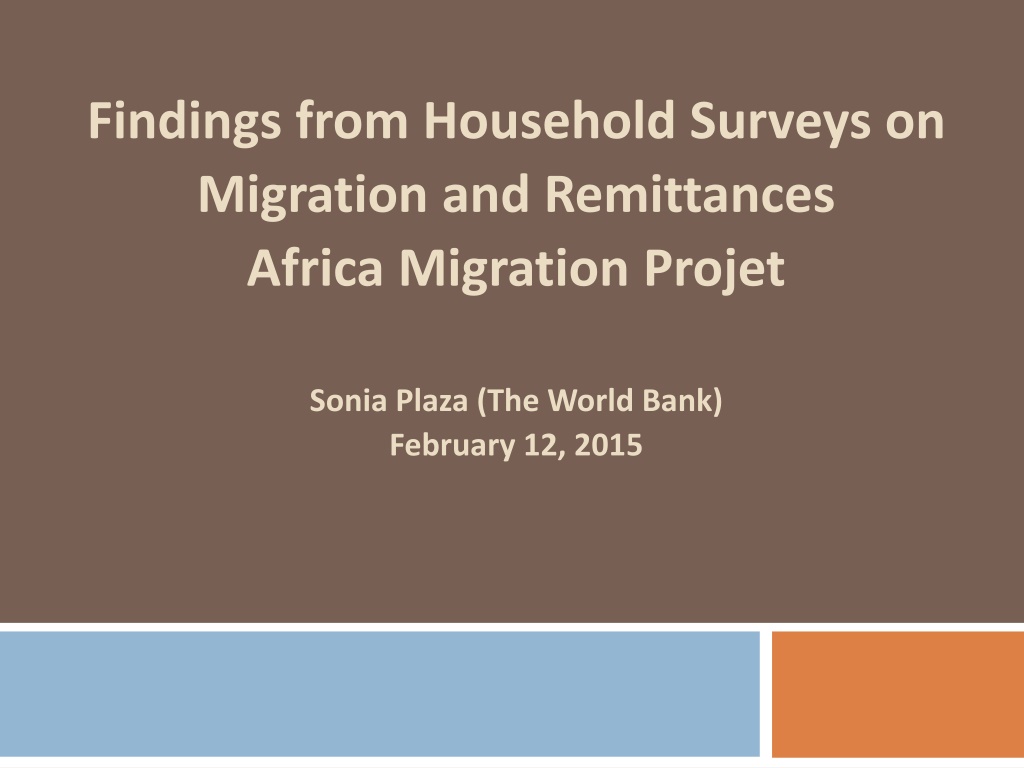
 undefined
undefined


 undefined
undefined




